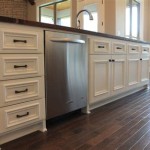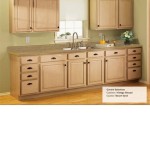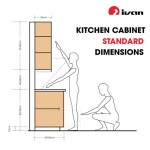Rejuvenating Non-Wood Kitchen Cabinets: A Comprehensive Guide
Kitchen cabinets form the backbone of a kitchen's functionality and aesthetics. While traditional wood cabinets have dominated the market, many homeowners now opt for non-wood options like thermofoil, laminate, or melamine. These materials offer durability, affordability, and a wide range of design choices. However, refinishing non-wood cabinets requires a different approach than wood cabinets.
Identifying the Cabinet Material
The first step in refinishing non-wood cabinets is to determine the material. This will dictate the appropriate refinishing techniques and materials.
- Thermofoil: A thin, vinyl-like material heat-bonded to a pressed wood core.
- Laminate: A thin, decorative layer of plastic or paper bonded to a durable surface.
- Melamine: A hard, scratch-resistant material made from resin-impregnated paper laminated onto particleboard.
Preparing the Cabinets
Once the material is identified, prepare the cabinets as follows:
- Remove all doors and drawers.
- Clean the surfaces thoroughly with a degreaser.
- Repair any cracks or dents with a suitable filler.
- Scuff-sand the surfaces lightly to create adhesion.
- Remove all dust and debris.
Refinishing Thermofoil Cabinets
Thermofoil cabinets can be repainted using a high-quality enamel or latex paint specifically formulated for vinyl. Follow these steps:
- Use a primer specifically designed for bonding to vinyl.
- Apply two thin coats of paint, allowing each coat to dry completely.
- Finish with a polyurethane sealant for added protection.
Refinishing Laminate Cabinets
Laminate cabinets are not typically repainted due to the difficulty of achieving a durable finish. Instead, consider:
- Contact paper: A self-adhesive paper available in various colors and patterns.
- Peel-and-stick tiles: Thin, self-adhesive tiles that create a tiled backsplash look.
- Replacing the laminate: Although labor-intensive, replacing the laminate with new material provides a fresh, updated look.
Refinishing Melamine Cabinets
Melamine cabinets can be repainted with a high-quality enamel or latex paint. Follow these steps:
- Use a primer specifically designed for bonding to melamine.
- Apply two thin coats of paint, allowing each coat to dry completely.
- Finish with a polyurethane sealant for added protection.
- Note:** Melamine is moisture-sensitive, so avoid using excessive water during cleaning and refinishing.
Additional Tips
- Test the paint or other refinishing materials on an inconspicuous area first to ensure compatibility.
- Use a high-quality brush or roller for a smooth finish.
- Allow ample drying time between coats.
- Protect the surrounding areas from paint or refinishing materials using masking tape or drop cloths.
- Consider hiring a professional for complex refinishing projects.
Refinishing non-wood kitchen cabinets can be a cost-effective way to update the look of your kitchen. By following these guidelines and using the appropriate materials and techniques, you can achieve professional-looking results that will enhance the functionality and beauty of your home.
Refinishing Kitchen Cabinets A Beautiful Mess

Cabinet Refinishing An 8 Step Guide For Pro Painters Ppc

Refinishing Kitchen Cabinets Modern Refacing Made Easy Wisewood

How To Refinish Cabinets Like A Pro

How To Paint Kitchen Cabinets Without Sanding Or Priming

How To Paint Unfinished Cabinets Houseful Of Handmade

How To Paint Laminate Kitchen Cabinets Perfect Finish Tips

How To Paint Fake Wood Kitchen Cabinets Simple Made Pretty 2024

How To Paint Veneer Cabinets For A Long Lasting Finish Anika S Diy Life

The Fast Affordable Way To Upgrade Your Kitchen Cabinet Refinishing
Related Posts








